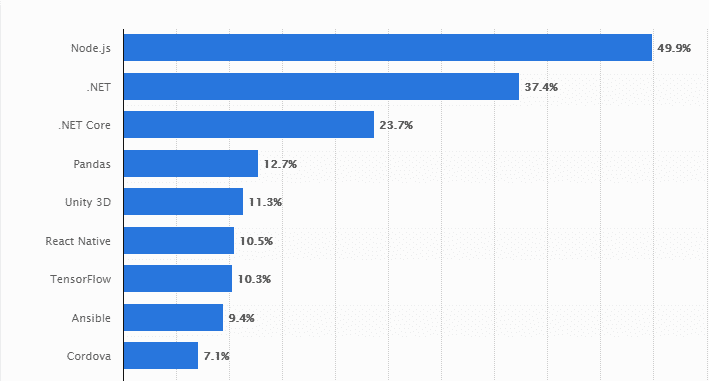For many developers, Node.js is a first choice because it allows them to use the same language on the client-side and the server-side.
Node.js is a runtime environment that uses V8, an open-source JavaScript engine that powers Google Chrome. It’s flexible, lightweight, and popular among businesses that hire Node.js developers for their projects.
Although technologies come and go, Node.js continues to remain at the top this year.

The top ten Node.js trends for the year 2022 are:
- MEAN/MERN
- GraphQL
- Real-Time Applications
- Serverless Architecture
- Microservices
- Internet of Things (IoT)
- Enterprise App Development
- Cloud Solutions
- API Servers
- Isomorphic Development
MEAN/MERN
MEAN and MERN are stacks for building web applications. MEAN consists of MongoDB, Node.js, Angular, and Express. MERN consists of MongoDB, Express, React, Node.js. Both frameworks simplify web development because they eliminate the need for context switching because they use fullstack JavaScript. As a result, they’re used by companies like Netflix, Paypal, LinkedIn, etc.
GraphQL
GraphQL is a query language that allows the client to request data from the server. Compared to REST, GraphQL can query any shape of data in a single request, which is great for performance and scalability. It’s become a growing trend in recent years.
GraphQL solves the developer’s challenge of under-fetching and over-fetching data by giving developers control and flexibility in how they fetch data from the frontend to the backend.
Real-Time Applications
Real-time applications provide convenience to end users. Since we expect technology to be instantaneous, it’s become a competitive advantage for systems to operate without latency or delay.
Node.js makes building real-time applications easy with the use of sockets. Some applications that utilize real-time functionality are chat apps, online games, social media, and more.
Serverless Architecture
Serverless allows the developer to spend less time managing infrastructure and more time building apps. Hence, the benefits of serverless are less cost, more deployments, and greater flexibility.
Additionally, there are many packages and frameworks that can speed up development. These aspects save a lot of time for developers, which is one of the reasons why developers choose Node.js.
Microservices
A microservice is an architectural pattern that provides advantages like simplicity, flexibility, and scalability. It addresses a challenge of monolithic systems by modularizing applications into smaller and independent parts. As a result, microservices are autonomous, isolated, and easier to maintain.
Internet of Things
The Internet of Things (IoT) is a growing trend of connecting physical objects with the internet. It can be used from crunching data to automating tasks and activities. Node.js makes it easy to integrate with IoT protocols. Moreover, many smart devices have JavaScript APIs.
Enterprise App Development
Beyond web development, Node.js and npm packages can be run in the command-line and cross-platform desktop applications. One such framework to develop desktop GUI applications is Electron. This adds to the convenience of using one language to build multiple systems.
Cloud Solutions
Many cloud providers—from AWS to Google Cloud Platform to Azure—support Node.js as a runtime environment. This makes it easy to run and deploy servers, APIs, queues, and other services on the cloud. The benefits of working in the cloud are cost, scalability, and not having to deal with infrastructure.
API Servers
Node.js allows the developers to manage multiple connections simultaneously and is able to convert POJO (Plain Old JavaScript Objects) into JSON. Creating an API server is very straightforward with frameworks like Express.
Isomorphic Development
Fullstack JavaScript saves developers the cost of context switching between the backend and the frontend. With isomorphic or universal development, this increases developer productivity and velocity. This means code can be shared and reused with backend and frontend code living in the same monorepo.
Conclusion
Node.js has many capabilities that fulfill the goals of businesses. If you’re looking to hire developers, why hire multiple developers across the stack when you can hire a single fullstack JavaScript developer that does everything?
These are the ten best Node.js development trends for the year 2022. As time passes, we see that startups continue to use Node.js because of the flexibility and ease that it provides. As a result, we’ll continue to see trends develop as the JavaScript environment continues to grow and progress.
About the Author:
Harikrishna Kundariya is a marketer, developer, IoT, ChatBot & Blockchain savvy, designer, co-founder, and Director of eSparkBiz Technologies.
His 10+ years of experience enables him to provide digital solutions to new start-ups based on IoT and ChatBot.

